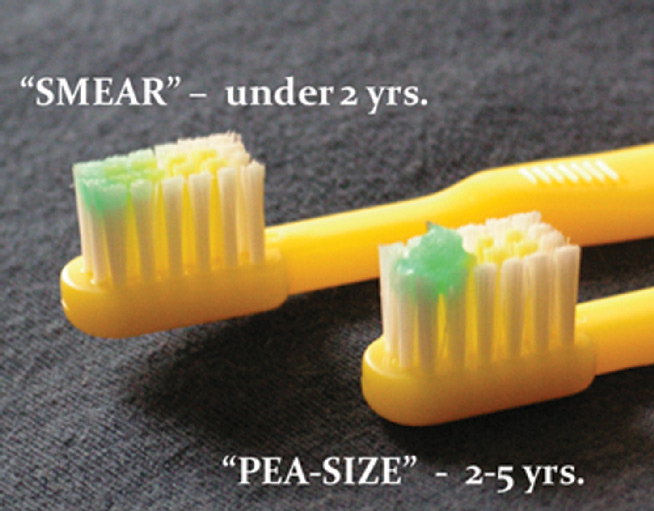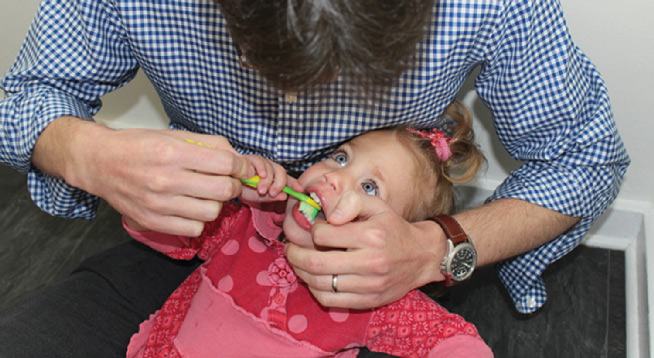
You may not know it, but dental cavities are the most common childhood disease, with more than half of children affected! Despite this surprising fact, for most children the disease is very preventable. This article hopes to give some helpful educational advice and tips to help you do all you can to prevent dental disease in your child.
Brushing with fluoridated toothpaste
A walk through the oral care aisle in the pharmacy can be very overwhelming with so many products claiming to prevent cavities! However, the best tools are something we are all familiar with, an old fashioned toothbrush and toothpaste. Many scientific studies have shown that the easiest and most effective way to prevent cavities in our children is routine and well-performed brushing with fluoride toothpaste. Covering all sides of the teeth in fluoride toothpaste daily provides a steady defense against the cavity process. For this to be effective, we need to be confident that the brushing is being performed properly. Therefore, we encourage parents to start brushing their children’s teeth as soon as they come in, and continue to help their children until they have the ability to brush well on their own, usually around age 7 or when they can tie their own shoelaces.
Fluoride
Like any other medicine, fluoride has recommended dosages that allow for the maximum benefit with minimum risk. Too much fluoride may result in a condition called fluorosis, which shows up as a white speckled appearance on the adult teeth. For this reason, different amounts of toothpaste are recommended for different age children to ensure that the optimal dose will always be given. These recommended amounts of toothpaste are calculated with the assumption that all the paste will be swallowed, which is unlikely and gives a large margin of safety. Once a child can reliably spit out toothpaste, the amount placed on the brush is not as critical. The following pictures illustrate the proper toothpaste amounts and proper tooth brushing positioning based on age:
The cause of cavities
Many people think that cavities are caused by sugar, but they really are caused by bacteria! That’s right, cavities are an infectious disease! Babies are not born with cavity causing bacteria, therefore it is important for parents to limit the amount of saliva sharing activities such as spoon sharing during the early months of a child’s life. Parents should also be careful not to place a pacifier in their own mouth to hold or clean it. Once colonized, these bacteria cause cavities by converting sugar into acid, which dissolves the teeth. After each instance of sugar entering the mouth, an acidic “cavity causing” environment lasts for about 30 minutes.
Diet
With this in mind, another important preventive factor is being careful about sugar in a child’s diet. Frequent encounters with sugary foods or drinks keep the mouth in a “cavity causing” environment for lengthy amounts of time which place the child at much higher risk for cavities. While it’s not realistic or fair to expect sugar to be removed from the diet, we recommend that sugary snacks or drinks only be given with a meal and for a limited amount of time. Cheese, fruits, vegetables, water, and plain milk are excellent between meal snacks that are actually good for the teeth!
Sealants
The most common site for cavities is on the pits and grooves of the teeth; these are called “pit and fissure” cavities. The cavity causing bacteria are able to easily find shelter in these areas and release acid without much difficulty. For many years, the only way to fight these cavities was keeping the grooves clean and using fluoride. Fortunately, dentistry has a much more powerful tool these days called “sealants.” These sealants are a liquid plastic material that is flowed into the pits and grooves of teeth then hardened with a blue light. The grooves are then protected from bacteria, thereby preventing the most common form of decay. Sealants are usually only applied to permanent molar teeth, once at age six and again at age twelve. They are checked at each cleaning and reapplied if needed, ensuring constant protection. Since their introduction, sealants have drastically reduced the amount of “pit and fissure” decay. It is important to note that modern sealant materials are BPA free.
Injuries to the mouth and teeth are fairly common in healthy and active children. At first, these injuries can appear very serious and scary, as the mouth has many blood vessels and will swell easily. However, most of these injuries will heal fully and quickly without any intervention from a dentist. There are three instances when immediate treatment is necessary to save the tooth:
-
An adult tooth is knocked out
-
A tooth is very loose due to injury
-
A child cannot bite down fully due to injury
If any of the above occur, a dentist should be seen right away and will be happy to accommodate you. Any other tooth injury still warrants a visit to dentist for an evaluation, but can wait until a convenient time.
Conclusion
We hope this guide gives you some helpful information and food for thought. Our main goal is to prevent children (and future adults) from experiencing this disease by education, prevention, and early intervention. A good early foundation associated with positive experiences sets up a child for a lifetime of healthy, fear-free dental care. We are committed to being engaged with the community to achieve this goal, so please let us know how we can help you!
By: Dr. Michael Kleinman
Dr. Michael Kleinman practices Pediatric Dentistry in Beverly Hills and Santa Monica. He firmly believes that almost all dental disease is avoidable and enjoys teaching parents about what preventative measures should be taken at home, including: proper oral hygiene, diet, and what to do in a dental emergency. He can be reached at mkleinmandds@gmail.com, (310) 657-6434, or online at: http://www.beverlyhillspedo.


